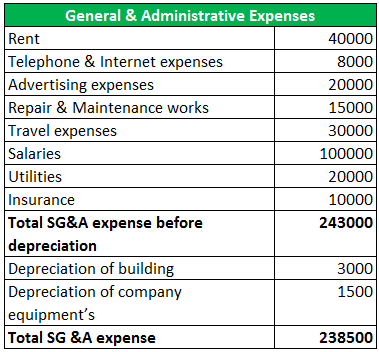SG&A is an important aspect of every business, especially if the goal of the company is to make a profit. It’s also one of the easiest ways to improve profitability. Therefore, this article will take you through the definition of SG&A expenses, examples, lists, and how you can reduce SG&A expenses. However, SG&A is also one of the first tools managers use to reduce excess through mergers or acquiring assets. Hence, this area is an easy target for a management team that’s looking to quickly boost profits.
SG&A Expenses Definition
SG&A means Selling General and Administrative Expenses. This includes all direct and indirect expenses incurred by a company at any duration or period of time. Therefore, including SG&A expenses such as rent, travels, meals, advertising, litigation, accounting, marketing, management salaries, bonuses, and more. In some cases, it could also include depreciation expense, depending on its relationship.
Understanding Selling (S) Expenses
Selling expenses can involve direct and indirect costs related to the sales of a product. Direct costs are costs directly connected to a certain product that has been sold. Indirect costs are items that you spend money on to make sales. You can only incur direct selling expenses when the product is sold, especially shipping supplies, delivery charges, and sales commissions. While Indirect selling expenses are costs incurred through the process of manufacturing and till the product is at its finished level.
Understanding General & Administrative (G&A) Expenses
G&A expenses are expenses made to grow and support the company. However, these are every day costs a company must incur in the day-to-day operations of a business. So, note that these expenses may not be directly related to any specific function or department within the company. They are what we’ll call fixed costs because they include rent or mortgage on buildings, utilities, and insurance. These costs may also include salaries of personnel including those related to sales or production.
SG&A Expenses Examples
Let’s look at a few SG&A expenses examples
Take, for instance, Rian concretes and Dulux announces a merger in 2021, the companies also announced 6,100 job cuts in an effort to save $830 million in expenses.
Here is another SG&A expenses example

SG&A Expenses List
SG&A expenses list may vary depending on your company. However, let look through some common SG&A expenses list:
- Rent
- Utilities
- Marketing, advertising, and promotion expenses
- Insurance payments
- Accounting costs
- Legal costs
- Office supplies
- Salaries, wages, and benefits for executives and staff not directly involved in manufacturing or other production tasks
- Equipment not associated with manufacturing, such as office computers
What Is the Difference Between Cogs and SG&A?
COGS refers to the direct expenses of making items sold and is the expense that most directly drives revenue. Aside from COGS, SG&A encompasses the majority of additional expenditures associated with running a corporation.
How Is SG&A Expense Calculated?
Interest is considered a “non-operating” expenditure, hence it is not factored into the computation (i.e. non-core). SG&A Expense = Gross Profit – Operating Income (EBIT)
What Expenses Are Not Included in SG&A?
Interest and taxes are not part of SG&A because they are taken out of operating income.
How to Reduce SG&A Expenses
#1. Cut Travel Costs
Where possible, cancel travels, replace them with phone calls, emails, and video meetings. If you must travel, plan ahead to avoid the high costs of a “sudden” trip. So, when you travel, stay in business hotels, rather than luxury hotels, as they are often half the cost of a five-star facility. Furthermore, use taxis to move around instead of renting a car.
#2. Eliminate Paper
Managing paper is time-consuming and expensive. Hence, sorting, filing, and finding files requires secretarial/clerical time and space. Why not purchase a scanner and digitize all important papers and keep them in well-organized electronic files to save space and administrative costs. Your company’s books and records are critical to your continued operation, so it is important to maintain and secure copies of the electronic files within your facility and in a remote location.
Hence, It should go without saying that files need to be backed up every day, especially any files regarding your customers’ identification, financial records, or contact information.
#3. Allocate Marketing Expenses
Identify products or services which complement your product. Then, contact the company that provides the products and negotiate a mutual marketing arrangement. For example, a swimming pool contractor might agree to joint marketing with a supplier of outdoor furniture, or multiple ethnic restaurants could promote an “International Food Experience” featuring each restaurant on a different night. As a result, this strategy tends to expand your marketing effort without incurring the expense that would normally be associated with adding new salesmen or advertising.
#4. Use the Internet
Everyone involved in the purchase of materials or supplies should have access to the Internet and know-how to search the data for specific items. However, try to establish a maximum cost per item with a policy that requires anyone purchasing items in excess of that value to use the Internet to identify potential suppliers and the lowest cost.
#5. Maintain Equipment In-House
If repair and maintenance is a significant cost in your operations, consider hiring a mechanic or specialist and bring the repair in-house. You will have better, regularly maintained equipment that may allow you to avoid expensive replacements until later.
#6. Sublease Office and Yard
If you have excess space that will not be used for a year or more, investigate subleasing. As a landlord, you will continue to control the premises and the activities performed in the space, and you’ll have extra income to offset the expense of your own facilities.
Before agreeing to sublet, you should be confident that space will not be needed during the term of the agreement. Include language in the contract for early termination if it becomes necessary. Your ability to reoccupy the space provides maximum flexibility and can be reflected in the agreement by either reducing the tenant’s rent during the term of the agreement or paying a penalty if termination becomes necessary.
#7. Monitor Tools and Supplies
Consumables are an invisible asset that is often overlooked. Since no item is expensive by itself, employees often misplace them, leave them, or take them home for personal use.
Initiate a consumables policy – keep office supplies in a secure area, available only through a designated employee. If you have a plant where hand tools or other pricy consumables are used, initiate a similar policy. Assign tools to individuals with the requirement that they are personally responsible for the cost of the tool if it’s lost or missing.
#8. Limit Travel and Entertainment Expenses
Client relations are always important and should never be compromised. However, the value of face-to-face meetings is not a function of lavish gifts and expensive dinners at luxury restaurants. Establish an entertainment policy that fits the economy; your clients and prospects will understand since their company is probably implementing similar policies.
#9. Don’t Purchase – Rent
The decision of whether to own or rent a property is generally based upon your scale of operations. Ownership or long-term leases increase your fixed costs and financial exposure. While month-to-month rental agreements tend to cost a little more in the short term, the ability to end the agreement and relocate to a more suitable space saves money and liability in the long run. In a fluctuating market, a wiser decision might be to limit your financial exposure, saving your cash for that time when you’re more comfortable with the market opportunities and an investment that will meet your criteria.
Do Salaries Fall Under SG&A?
Selling, General, and Administrative expenses (SG&A) encompass all corporate operational costs that are not directly related to the manufacturing of goods or delivery of services. SG&A expenditures typically consist of rent, payroll, advertising and marketing charges, and distribution costs.
Frequently Asked Questions
What is included in SG&A expenses?
Sales commissions, advertising, promotional materials, remuneration of the company’s officers as well as the marketing, sales, finance, and office staffs, rent, utilities, supplies, computers, and other SG&A expenses are all included as long as they are not related to manufacturing. equipment and employee benefits are among them.
Is SGA an overhead?
Because they cannot be traced back to the creation of a product or service, SG&A expenses are often associated with a company’s overall overhead. SG&A covers almost anything that isn’t covered by the cost of products sold (COGS).
What is the difference between COGS and SG&A?
COGS refers to all items above the line, such as direct material, direct labor, and other direct expenses related to the company’s manufacturing or core activity. All costs below the line are referred to as SG&A (selling, general, and administrative).
- Money Management: Top 10+ Easy Tips to Becoming a Pro
- VIRTUAL ASSISTANT BUSINESS: 2022 Detailed Start-Up Guide (+ Free Tips)
- Banking and Finance: Why is it the most preferred career choice? (+ detailed guide)
- Security Agreement: How to use the General Security Agreement Template (+ Detailed Guide)
- Personal Finance: Basics, Importance, Types, Management ( + Free Software)






